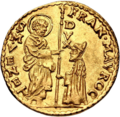Sardinian lira
Appearance
This article has multiple issues. Please help improve it or discuss these issues on the talk page. (Learn how and when to remove these template messages)
|
| lira ( Pegged by | French franc | |
|---|---|---|
| This infobox shows the latest status before this currency was rendered obsolete. | ||
The lira (plural lire) was the currency of the Kingdom of Sardinia between August 6, 1816, and March 17, 1861.
History
It was subdivided into 100 centesimi (singular centesimo) and was equal in value to the
Italian unification. Similar to the majority of 19th century currencies, the Sardinian lira was not affected by significant episodes of inflation
during all its existence.
Coins

In 1816, King
Victor Emmanuel I
issued silver £5 and gold £20 coins. Before his abdication in 1821, he also issued a new gold £80 coin.
King Charles Felix followed in 1821 and 1822 minting gold £40 and £80, respectively. He also expanded the new currency in Sardinia which, not having been conquered by Napoleon, had retained its Sardinian scudo. Silver c.50, £1 and £2 were added in 1823, followed by copper c.1, c.3 and c.5 in 1826, and silver c.25 in 1829.
Finally, King Charles Albert added new gold £10, £50 and £100 in 1832, while King Victor Emmanuel II continued his father's coinage.
On each coin, the ruling monarch was styled in
Latin
as King of Sardinia, Cyprus and Jerusalem by the Grace of God on the front side, and Duke of Savoy, Genoa and Montferrat, Prince of Piedmont et cetera on the back side.
See also
References
- Krause, Chester L.; Clifford Mishler (1991). ISBN 0873411501.

